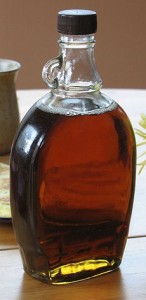 In spite of the wintry landscape, the steady tap-tap-tap of maple sap dripping into a bucket announces spring with greater assurance than the calendar. Black-capped chickadees have been singing their "cheese-burgers, cheese-burgers" song for over a month, but that is more based on hope and expectations than reality. The flow of sap through the stems of trees, on the other hand, signals hormonal changes in the plant that is based both on photoperiod and temperature patterns. The combination of longer days coupled with frigid nights and daytime highs well above freezing results in enzymes that regulate conversion of stored starch in the roots to sugars. The concentration of sugars in the roots, causes water below the frost-line to move into tree roots. The pressure builds high enough to force sugary sap up the trunks to branches where buds begin to swell and expand with the new life within. During the cold nights, the sap will freeze in the exposed stems, causing the pressure to build deep in the soil where roots are protected from freezing. As the sun warms the stems the following day, sap is forced up with remarkable pressure. Boring a hole into the sapwood intercepts some of the xylem cells through which the sap is flowing, allowing the sap to run out of the stem.
In spite of the wintry landscape, the steady tap-tap-tap of maple sap dripping into a bucket announces spring with greater assurance than the calendar. Black-capped chickadees have been singing their "cheese-burgers, cheese-burgers" song for over a month, but that is more based on hope and expectations than reality. The flow of sap through the stems of trees, on the other hand, signals hormonal changes in the plant that is based both on photoperiod and temperature patterns. The combination of longer days coupled with frigid nights and daytime highs well above freezing results in enzymes that regulate conversion of stored starch in the roots to sugars. The concentration of sugars in the roots, causes water below the frost-line to move into tree roots. The pressure builds high enough to force sugary sap up the trunks to branches where buds begin to swell and expand with the new life within. During the cold nights, the sap will freeze in the exposed stems, causing the pressure to build deep in the soil where roots are protected from freezing. As the sun warms the stems the following day, sap is forced up with remarkable pressure. Boring a hole into the sapwood intercepts some of the xylem cells through which the sap is flowing, allowing the sap to run out of the stem.
It is remarkable that a half inch hole, which represents perhaps no more than 1/50th of the circumference of sapwood of the stem, can bleed a gallon or two a day, suggesting that as much as 50 to 100 gallons of sap can move up even a modest-sized tree in 24 hours. Over two to four weeks, the amount of sap moving up the stem of a tree that is little more than a foot in diameter could easily equal 1000 gallons or more. Spring is one of the wonderful results of higher latitudes, where significant change in day length and temperature have resulted in adaptations that dramatically play out, not only in chickadees and maples, but in every native species, including humans.
No wonder spring is a favorite of poets and farmers, lovers and philosophers. No doubt in days before modern technology removed most of the discomfort and risks of months of long nights, snow, and freezing conditions, spring represented survival for another year, and the relief and joy lies deep in our subconscious like the stored sugars in the roots of the maple. Perhaps it is projection, but it takes no imagination to hear the joy in the song of returning bluebirds, or in the delighted cries of the cranes, or excited talking among the flocks of geese passing overhead. I thrill at those sounds, and never tire of hearing them. Still, for me, the tap-tap-tap of the maple sap in the bucket reaches deep and pulls forth a feeling of wholeness and connectedness. Maple sap in a bucket is different than tomatoes in a basket fresh from the garden. Both represent the fullness of the union between me and the earth, but the sap also represents spring and the beginning a new year. Wrapped up in the sap is an entire year, or even many decades if we consider the years the tree required to reach a size when it can share its bounty.
There is only a narrow window when that bounty can be harvested, the time between release of the stored sugars in the root and the breaking of buds when the sugar level in the sap quickly drops and less palatable compounds are produced. Thus, sap flow is the interface between winter and summer when all life is beginning to stir. There is also the comfort of knowing that properly managed; the maple tree will continue to live for decades, offering a share of its sweet bounty year after year.
My grandfather tapped maples on his farm that were first tapped by his grandfather. The fresh tomato is a connection to the land like the snapshot is to the landscape. In contrast, maple sap is a connection to the land like a forest is to the landscape, a living system cycling through the years. It is time to go gather the sap. Soon the clouds of steam coming off the boiler will return the water to the atmosphere that was gathered by the roots of the maple two days ago. Some of that water will return to the soil as snow or rain, to replenish that which the maple withdrew. Fitting into the natural cycles carefully, so as not to disrupt them, is yet another joy of being connected—a part of the wholeness of nature.


